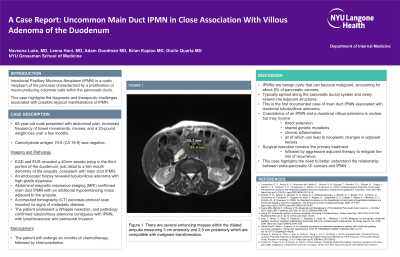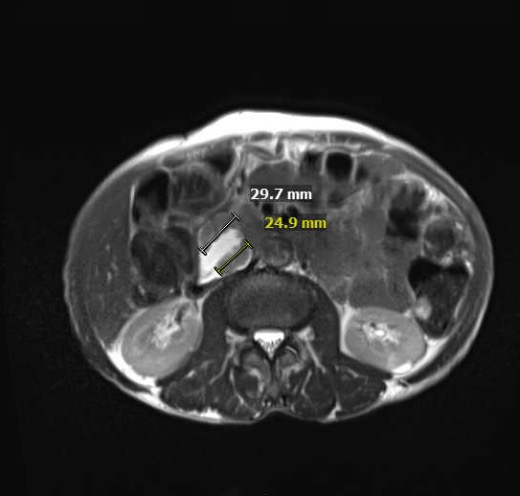Tuesday Poster Session
Category: Biliary/Pancreas
P3536 - Uncommon Main Duct IPMN in Close Association With Villous Adenoma of the Duodenum
Tuesday, October 29, 2024
10:30 AM - 4:00 PM ET
Location: Exhibit Hall E

Has Audio

Naveena Luke, MD
NYU Langone Health
New York, NY
Presenting Author(s)
Naveena Luke, MD1, Leena Hani, MD2, Adam J. Goodman, MD3, Brian Kaplan, MD1, Giulio Quarta, MD2
1NYU Langone Health, New York, NY; 2NYU Langone Health, Brooklyn, NY; 3NYU Grossman School of Medicine, Brooklyn, NY
Introduction: Intraductal Papillary Mucinous Neoplasm (IPMN) is a cystic neoplasm of the pancreas characterized by a proliferation of mucin-producing columnar cells within the pancreatic ducts.1, 2 We report a case of IPMN with associated tubulovillous adenoma of the duodenum. This case highlights the diagnostic and therapeutic challenges associated with possible atypical manifestations of IPMN.
Case Description/Methods: A 65-year-old male with a medical history of diabetes mellitus and hypertension presented with abdominal pain, increased frequency of bowel movements, nausea, and a 20-pound weight loss over a few months. Evaluation via esophagogastroduodenoscopy (EGD) and endoscopic ultrasound (EUS) revealed a 40mm sessile polyp in the third portion of the duodenum, just distal to a fish mouth deformity of the ampulla, consistent with main duct IPMN. An endoscopic biopsy revealed tubulovillous adenoma with high-grade dysplasia. Abdominal magnetic resonance imaging (MRI) confirmed main duct IPMN with an additional hypoenhancing mass adjacent to the ampulla. A computed tomography (CT) pancreas protocol scan reported no signs of metastatic disease. Carbohydrate antigen 19-9 (CA 19-9) was negative. The patient underwent a Whipple resection, and pathology confirmed tubulovillous adenoma contiguous with IPMN, with lymphovascular and perineural invasion. The patient will undergo six months of chemotherapy, followed by chemoradiation.
Discussion: IPMNs are benign cysts that can become malignant, accounting for about 8% of pancreatic cancers.3
IPMNs typically spread along the pancreatic ductal system and rarely extend into adjacent structures. While there have been reports of pancreatic IPMN presenting as a duodenal tumor causing obstruction4 and IPMN associated with increased incidence of extra-pancreatic gastrointestinal (GI) cancers5-8 this appears to be the first documented case of main duct IPMN associated with duodenal tubulovillous adenoma. The exact mechanism behind the coexistence of an IPMN and a duodenal villous adenoma is unclear, but may involve direct extension, shared genetic mutations, and chronic inflammation, all of which can lead to neoplastic changes in adjacent tissues. Surgical resection remains the primary treatment, followed by aggressive adjuvant therapy in this case to mitigate the risk of recurrence. This case highlights the need to better understand the relationship between extra-pancreatic GI cancers and IPMN and the role of endoscopic surveillance for these patients.

Disclosures:
Naveena Luke, MD1, Leena Hani, MD2, Adam J. Goodman, MD3, Brian Kaplan, MD1, Giulio Quarta, MD2. P3536 - Uncommon Main Duct IPMN in Close Association With Villous Adenoma of the Duodenum, ACG 2024 Annual Scientific Meeting Abstracts. Philadelphia, PA: American College of Gastroenterology.
1NYU Langone Health, New York, NY; 2NYU Langone Health, Brooklyn, NY; 3NYU Grossman School of Medicine, Brooklyn, NY
Introduction: Intraductal Papillary Mucinous Neoplasm (IPMN) is a cystic neoplasm of the pancreas characterized by a proliferation of mucin-producing columnar cells within the pancreatic ducts.1, 2 We report a case of IPMN with associated tubulovillous adenoma of the duodenum. This case highlights the diagnostic and therapeutic challenges associated with possible atypical manifestations of IPMN.
Case Description/Methods: A 65-year-old male with a medical history of diabetes mellitus and hypertension presented with abdominal pain, increased frequency of bowel movements, nausea, and a 20-pound weight loss over a few months. Evaluation via esophagogastroduodenoscopy (EGD) and endoscopic ultrasound (EUS) revealed a 40mm sessile polyp in the third portion of the duodenum, just distal to a fish mouth deformity of the ampulla, consistent with main duct IPMN. An endoscopic biopsy revealed tubulovillous adenoma with high-grade dysplasia. Abdominal magnetic resonance imaging (MRI) confirmed main duct IPMN with an additional hypoenhancing mass adjacent to the ampulla. A computed tomography (CT) pancreas protocol scan reported no signs of metastatic disease. Carbohydrate antigen 19-9 (CA 19-9) was negative. The patient underwent a Whipple resection, and pathology confirmed tubulovillous adenoma contiguous with IPMN, with lymphovascular and perineural invasion. The patient will undergo six months of chemotherapy, followed by chemoradiation.
Discussion: IPMNs are benign cysts that can become malignant, accounting for about 8% of pancreatic cancers.3
IPMNs typically spread along the pancreatic ductal system and rarely extend into adjacent structures. While there have been reports of pancreatic IPMN presenting as a duodenal tumor causing obstruction4 and IPMN associated with increased incidence of extra-pancreatic gastrointestinal (GI) cancers5-8 this appears to be the first documented case of main duct IPMN associated with duodenal tubulovillous adenoma. The exact mechanism behind the coexistence of an IPMN and a duodenal villous adenoma is unclear, but may involve direct extension, shared genetic mutations, and chronic inflammation, all of which can lead to neoplastic changes in adjacent tissues. Surgical resection remains the primary treatment, followed by aggressive adjuvant therapy in this case to mitigate the risk of recurrence. This case highlights the need to better understand the relationship between extra-pancreatic GI cancers and IPMN and the role of endoscopic surveillance for these patients.

Figure: There are several enhancing masses within the dilated ampulla measuring 3 cm anteriorly and 2.5 cm posteriorly which are compatible with malignant transformation.
Disclosures:
Naveena Luke indicated no relevant financial relationships.
Leena Hani indicated no relevant financial relationships.
Adam Goodman: Ambu, Inc – Consultant. Boston Scientific – Consultant. Motus GI Holdings – Consultant.
Brian Kaplan indicated no relevant financial relationships.
Giulio Quarta indicated no relevant financial relationships.
Naveena Luke, MD1, Leena Hani, MD2, Adam J. Goodman, MD3, Brian Kaplan, MD1, Giulio Quarta, MD2. P3536 - Uncommon Main Duct IPMN in Close Association With Villous Adenoma of the Duodenum, ACG 2024 Annual Scientific Meeting Abstracts. Philadelphia, PA: American College of Gastroenterology.
